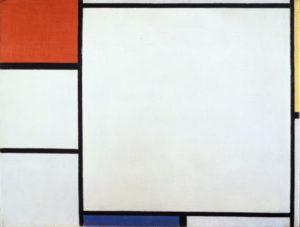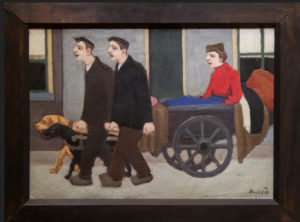post 9 Collective pursuit of the universal
Individuals vs collectives
In our hyper-individualist times it is sobering to revisit the world of creative artists and their collective pursuit of the ‘universal’ a hundred years ago. No doubt the horrors of the first world war and its destruction of the ‘normal’ had a role to play (see also post 7 about Paul Nash).
In the wake of innumerable deaths and disturbed minds, trying to give new meaning to society and the role of the arts made sense. This may explain the many artistic movements in the first half of the 20th century and their need to lay down a road map for a new future in their manifestos. Surrealism and de Stijl formed part of these movements: dadaism, cubism, abstract expressionism, suprematism, modernism among them.
De Stijl and Surrealism exhibitions
Two exhibitions from this period were staged by Dutch museums at the same time. What they have in common is their drive to work collectively toward a new future.
100 years of De Stijl: Mondrian to Dutch Design
This exhibition in the municipal museum of The Hague, designed by Hendrik Petrus Berlage (a member of CIAM, ‘congres international de [‘architecture moderne’) – which holds the largest Mondrian collection in the world – marked the centenary of the foundation of de Stijl in 1917.
It focused on Piet Mondrian and Bart van der Leck during the period when they pursued abstraction and influenced each other.
While Mondrian continued his trajectory toward abstraction which lived on in later artist movements the more polymath van der Leck who had produced posters and typefaces before kept and returned to some figurative dimension in his paintings, stain glass windows, pottery and tapestry.
De Stijl was thus an intense but short lived movement among Dutch painters (Theo van Doesburg who taught at the Bauhaus, Piet Mondrian, Vilmos Huszar, Ilya Bolotowsky, Georges Vantongerloo, Bart van der Leck) and architects (Gerrit Rietveld, JJP Oud, Jan Wils, Robert Van’t Hoff). In its manifesto with what some considered utopian objectives de Stijl aspired to a new aesthetic based on geometric abstraction in reaction to the decorative excesses of the imperial era eradicated by the first world war.
The manifesto was universalist: “there are two types of knowledge, one ancient and one new, the ancient one is oriented towards individualism, the new one towards the universal”… “The debate between individualism and universalism is revealed in the world war as well as in the art of our time”… “Contemporary artists…sympathise with all those who fight spiritually or materially for the creation of an international unity of Life, Art and Culture”. Its rationalism lived on in modernism until it was counteracted by post-modernism and the eclecticism of our time.
Mad about Surrealism
This exhibition was curated by the Boijmans Van Beunginen Museum in Rotterdam, itself endowed with a large collection of surrealist paintings. It brought together many works from private collections which influenced the concept of the exhibition. Four rooms were attributed to works from respective collectors Gabrielle Keiller, Edward James, Roland Penrose, Ulla and Heiner Pietzsch, and one thematic room divided into chance, automatism, Magritte’s extraordinary everyday reality, the poetry of Delvaux, fabulous women, Max Ernst’s ominous landscapes, Salvador Dali’s paranoia and desirable objects. Although on the opposite side of the rationality of de Stijl and more international and multi-disciplinary the surrealists had also produced their own publications and a manifesto issued in 1924 and 1929 written by the poet Andre Breton.
Although declaring themselves non conformists the surrealists had also pursued collective action among their followers, ranging from writers, to musicians, painters, sculptors, film makers and performing artists. Uprooted by the world war (Breton treated soldiers for shell shock) and its destruction of the established world order, they tried to reconcile reality with dream by means of automatism and absurdity, thereby re-imagining the relation between everyday material realities to influence societal change. Surrealism too was overtaken by other eclectic artist pursuits: installations, videos (often about themselves), concepts rather than products, as well as the commodifying role of the art market.
What place of the arts and artists today?
What is striking about these two exhibitions and their times is that it was artists, renowned as individualistic non conformists who united into a collective to work on a new order for post war shattered society. In today’s globalising, neo-liberal, austerity driven world, ruled by the 1% we may well want to turn to artists again and ask whether they intend to adopt a collective position once more to help turn our dysfunctional divisive era into a better future world.











